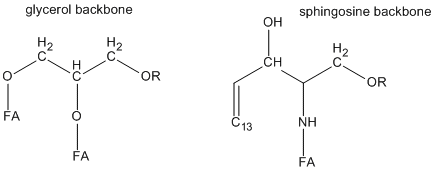Biochemistry Online: An Approach Based on Chemical Logic

CHAPTER 1 - LIPID STRUCTURE
C: Dynamics of Membrane Lipids
BIOCHEMISTRY - DR. JAKUBOWSKI
02/12/2016
Learning Goals/Objectives for Chapter 1C: After class and this reading, students will be able to
|
C3. Lipid Rafts
Not only are lipids asymmetrically distributed between leaflets of a bilayer, they are also distributed asymmetrically within a single leaflet. Certain lipids often cluster within a leaftlet to form lipid "rafts" which can be considered to result from a lateral phase separation of the lipids within one leaflet of the bilayer. Divalent cations like calcium, which can bind to negatively charged PLs like PS, can cause "rafts" of PS to form, giving rise to lateral asymmetry within a leaftlet of a bilayer. Rafts also appear to be enriched in cholesterol and lipids with saturated fatty acids, especially sphingolipids, which would lead to regions of enhanced packing and reduced fluidity. Cholesterol would stabilize packing in spaces created with lipids with large head groups.
Cholesterol appears to be a key player in the formation of lipid rafts. It is planar and inflexible and would pack better with saturated fatty acid chains and could also induced them to elongate to form lower energy zig-zag structures in which all the methylene groups are anti. Lipid rafts would represent a more ordered lipid phase (Lo) compared to the more disordered surrounding phase (Ld). Also compared to the structure of glycerophospholipids, the atoms in the region linking head group and the nonpolar fatty acid chains in sphingolipids have greater potential for H bond interactions with cholesterol and other sphingolipids, as shown below.
Figure: Comparison of glycerol and sphingosine headgroup structure

Rafts probably bind or exclude binding of other biological molecules like proteins. Some proteins are chemically modified with a glycosylphosphoinositol (GPI) group at the carboxy terminus. The PI group can insert into the membrane, anchoring the protein to the bilayer. Protein also appear to induce raft formation. Lipids rafts appear to be enriched in GPI-anchored proteins. Recent studies have shown that the Ebola virus interacts with lipid rafts in the process of entering and exiting the infected cell. Rafts are also involved in how cells sense and respond to their environment. Signaling molecules on the outside of the cell can bind receptor proteins in the membrane. As we will see later, conformational changes in the receptor protein signals the inside of the cells that the receptor is bound with a ligand. Once bound, the receptor can move in the membrane and often cluster in outer leaflet rafts that contain cholesterol and sphingolipids. Inner leaflet rafts have also been observed. The figure below shows two versions of an animated version of a lipid raft. The large shapes represent membrane proteins selectively found in the rafts (a topic which will be discussed in Chapter 2G). The most modern definition of a lipid raft is a nanoscale assemblies of sphingolipids, cholesterol and proteins that can be stabilized into platforms.
Figure:
Lipid Rafts enriched in SM and Cholesterol
(screen capture from:
http://multimedia.mcb.harvard.edu/anim_innerlife.html )

Navigation
Return to Chapter 1C: Dynamics of Membrane Lipids
Return to Biochemistry Online Table of Contents
Archived version of full Chapter 1C: Dynamics of Membrane Lipids